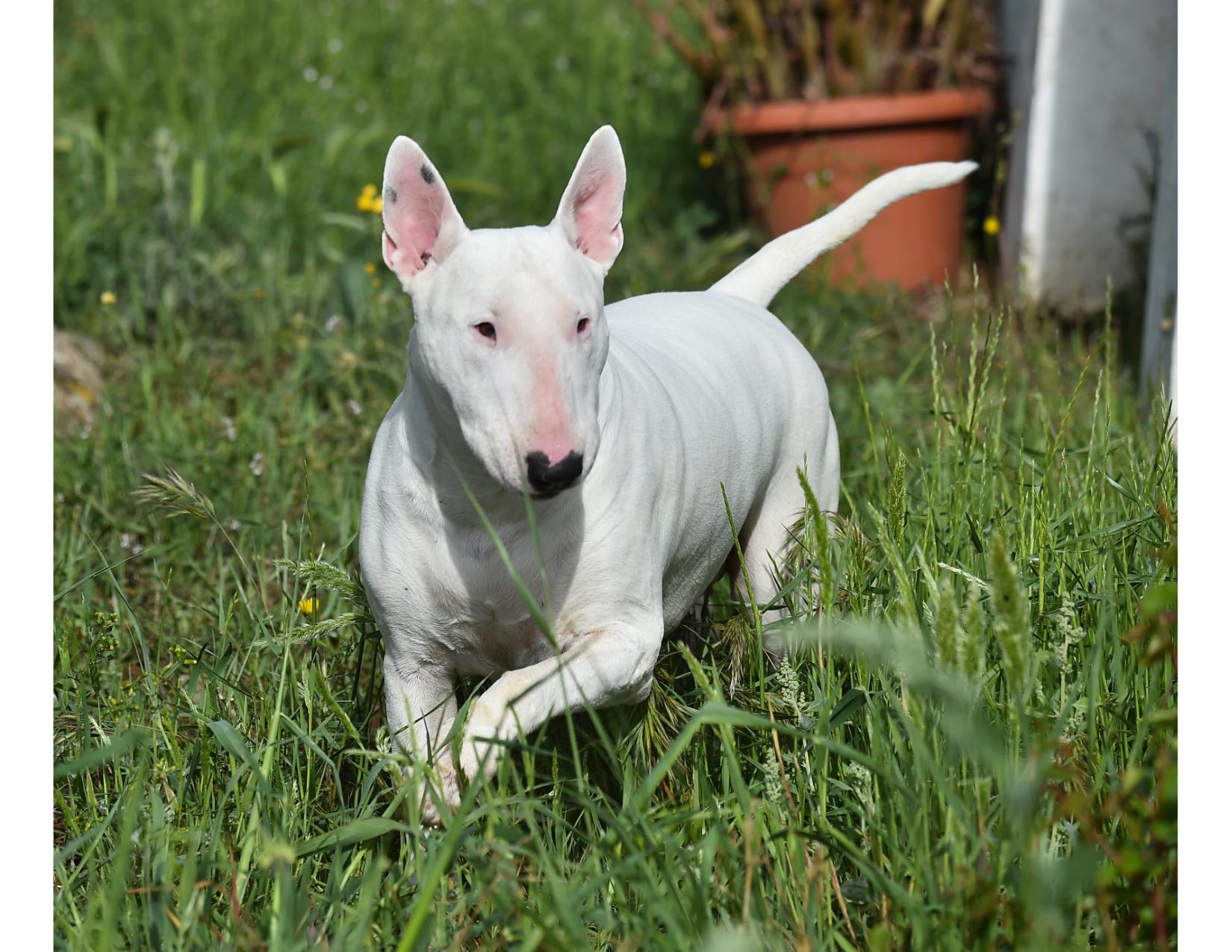BULL TERRIER
| Group: | Terrier |
|---|---|
| Size: | Large |
| Temperament: | Playful, endearing, and sly |
| Height: | 20-22 inches (male), 19-21 inches (female) |
| Weight: | 27-32 Kg (male), 22-27 Kg (female) |
| Life Expectancy: | 10-12 years |
| Origin: | UK |
| Coat Length: | Short |
| Coat Type: | Smooth |
| Color: | Black Brindle & White Black Tan & White Brindle Brindle & White Red Red & White White White & Brindle White & Red White Black & Tan Black Brindle White & Black Brindle |
About
Bull Terriers have a champion's physique, with strong muscles and a stride that exudes quickness and strength. But what truly distinguishes them is their peculiar egg-shaped head with pointed ears and mischievously gleaming eyes. A well-bred Bull Terrier is the epitome of equilibrium and tenacity. They will constantly make you grin and keep you on your toes given that they're loyal, loving, and endlessly entertaining.
Nutrition
Make sure your Bull Terrier is receiving the proper nourishment if you want them to be as robust and healthy as possible. Give them lots of natural calcium when they're young, such as a little yoghurt or whole milk. Add some broccoli to the diet if they are experiencing a growth spurt to aid in the development of their bones. Yet if you're not cautious, these puppies may put on weight quickly. Thus, monitor their weight and restrict the snacks they consume. And make sure the food is safe for your animal companion before feeding them any old human food. Of course, you should always make sure they have access to clean water.
Ideal Meal Breakdown
Protein
33
Fat
17
Carbohydrates
42
Others
8
Exercise
Bull Terriers require both instruction and activity. Bull Terriers that have received proper training are content and self-assured. Early on, begin educating them and exposing them to diverse situations and people. These bright dogs respond well to positive reinforcement training methods. Bull Terriers can be obstinate, but effort and patience can help you get through this. They require consistent activity, such as walks, backyard games, or dog sports. Agility, tracking, and obedience training come naturally to them. These devoted and affectionate dogs benefit from appropriate socialisation and training. Make sure your Bull Terrier gets the training and activity they require to be their best selves.
Grooming
The short, flat, rough, and glossy coat of the Bull Terrier requires little upkeep. A weekly brushing with a soft-bristle brush or hound glove will help keep the dog looking his best by removing dirt and loose hair. Regular checks and cleanings of the ears are advised. Trim their nails as long nails can make the dog uncomfortable and make it difficult for them to run and walk.
Training
Although the breed has the toughness and bravery of the Bulldog, owners must remember that it also belongs to the Terrier Group. This character is self-sufficient, uninhibited, and more committed to "fun and games" than to a solid work ethic. Bull Terriers live by the maxim that they will engage in any fun activity. Make training fun, and they'll learn quickly. Using food or toys as positive reinforcement is a terrific place to begin. Bull Terriers are good in a range of dog sports, in addition to jobs including bomb detection, search and rescue, and service, assistance, health-alert, and therapy dogs. Bull Terriers can do anything if trained positively and patiently.
Health
Bull Terriers are an inherently healthy breed. Nonetheless, they have the same health risks as other dogs, including patellar luxation, genetic skin allergies, hereditary renal disease, congenital deafness, and eye disorders like cataracts, glaucoma, and retinal atrophy. In order to ensure your Bull Terrier's general health and wellbeing, regular vet appointments, a healthy diet, exercise, and proper grooming are all required.
History
Bull Terrier breed first originated in England in the middle of the 19th century. It was first created as a companion animal but was originally bred for dogfighting. Bull-baiting was a popular past time in Britain starting in the 13th century. Bulldogs were turned lose on a staked bull while onlookers wagered on the result. Animals were not used in blood sports by the more progressive 1830s. Those who enjoyed watching such gory spectacles were unaffected by this. To avoid the law, they simply went underground. Bull-baiting was obviously too obvious a practise to continue in secret. Instead, dogfighting, which often takes place in the cellars of taverns, involves dogs mauling other dogs in enclosed pits. Bulldogs proved to be too slow and plodding in these gory affairs to offer much entertainment. In order to create fighters with the strength of a Bulldog and the energy and fiery spirit of terriers, Bulldogs and terriers were crossed. The Bull Terrier was one of the breeds that was developed in this way.
